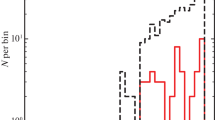Abstract
The detection of X-rays from Nova Muscae 1983 (discovered on January 18, 1983) constitutes the first detection of X-rays from a classical nova during outburst. X-ray observations were carried out on 1984 April 20 and July 14 when Nova Mus had entered the nebular stage. During both observations no significant flux was observed with the medium energy detectors (2–50 keV). The source was detected with the low energy detector (.04–2 keV) using 3000 Å Lexan and Parlene- N-Aluminium filters; counting rates of (3.4 ± 1.2) × 103 and (3.7 ± 1.2 × 10-3 counts/sec were measured with the respective filters. The source was detected again on July 14 with about the same intensity. Either a shocked shell of circumstellar gas emitting 107 thermal bremsstrahlung at 1035 erg/sec intensity or a white dwarf remnant emitting 3.5 × 105 blackbody radiation at 1037 erg/sec luminosity are compatible with the measurements.
Spectra taken in the visual spectral range show strong forbidden coronal emission lines of [FeVII] λ6085, [FeX] λ6374, and as never observed before in such a strength, [FeXIV] λ5303 requiring excitation temperatures of ∼ 2 × 106 °K.
Similar content being viewed by others
Author information
Authors and Affiliations
Rights and permissions
About this article
Cite this article
Krautter, J., Beuermann, K. & Ögelman, H. X-ray and optical observations of Nova Muscae 1983 during its nebular stage. Space Sci Rev 40, 156 (1985). https://doi.org/10.1007/BF00212880
Issue Date:
DOI: https://doi.org/10.1007/BF00212880



